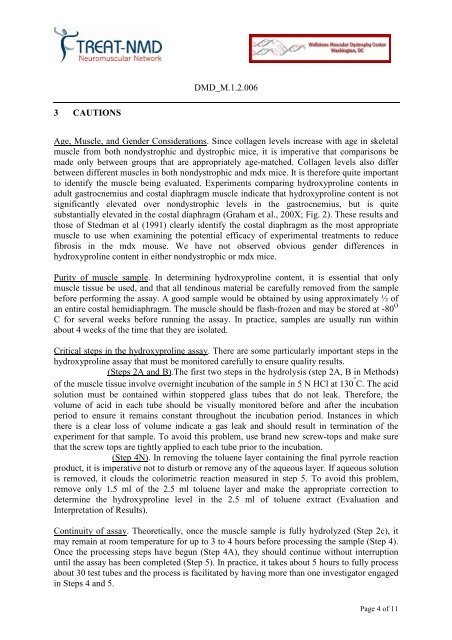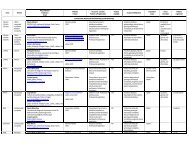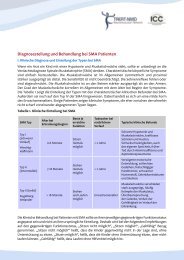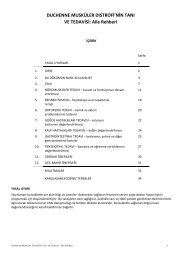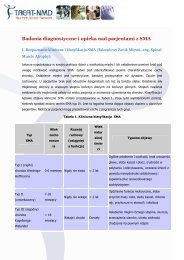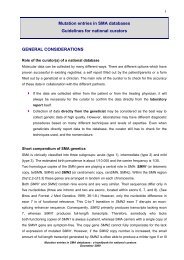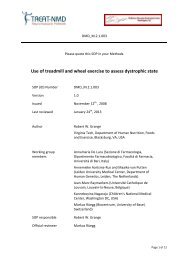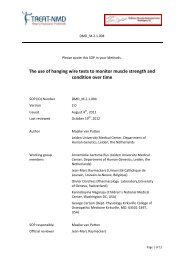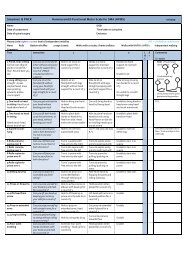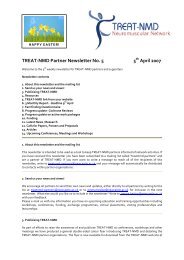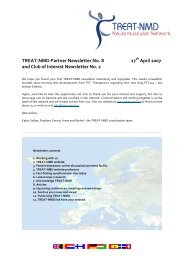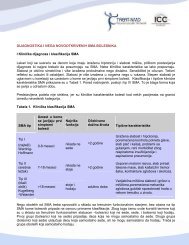Hydroxyproline assay - Treat-NMD
Hydroxyproline assay - Treat-NMD
Hydroxyproline assay - Treat-NMD
You also want an ePaper? Increase the reach of your titles
YUMPU automatically turns print PDFs into web optimized ePapers that Google loves.
DMD_M.1.2.006<br />
3 CAUTIONS<br />
Age, Muscle, and Gender Considerations. Since collagen levels increase with age in skeletal<br />
muscle from both nondystrophic and dystrophic mice, it is imperative that comparisons be<br />
made only between groups that are appropriately age-matched. Collagen levels also differ<br />
between different muscles in both nondystrophic and mdx mice. It is therefore quite important<br />
to identify the muscle being evaluated. Experiments comparing hydroxyproline contents in<br />
adult gastrocnemius and costal diaphragm muscle indicate that hydroxyproline content is not<br />
significantly elevated over nondystrophic levels in the gastrocnemius, but is quite<br />
substantially elevated in the costal diaphragm (Graham et al., 200X; Fig. 2). These results and<br />
those of Stedman et al (1991) clearly identify the costal diaphragm as the most appropriate<br />
muscle to use when examining the potential efficacy of experimental treatments to reduce<br />
fibrosis in the mdx mouse. We have not observed obvious gender differences in<br />
hydroxyproline content in either nondystrophic or mdx mice.<br />
Purity of muscle sample. In determining hydroxyproline content, it is essential that only<br />
muscle tissue be used, and that all tendinous material be carefully removed from the sample<br />
before performing the <strong>assay</strong>. A good sample would be obtained by using approximately ½ of<br />
an entire costal hemidiaphragm. The muscle should be flash-frozen and may be stored at -80 O<br />
C for several weeks before running the <strong>assay</strong>. In practice, samples are usually run within<br />
about 4 weeks of the time that they are isolated.<br />
Critical steps in the hydroxyproline <strong>assay</strong>. There are some particularly important steps in the<br />
hydroxyproline <strong>assay</strong> that must be monitored carefully to ensure quality results.<br />
(Steps 2A and B).The first two steps in the hydrolysis (step 2A, B in Methods)<br />
of the muscle tissue involve overnight incubation of the sample in 5 N HCl at 130 ° C. The acid<br />
solution must be contained within stoppered glass tubes that do not leak. Therefore, the<br />
volume of acid in each tube should be visually monitored before and after the incubation<br />
period to ensure it remains constant throughout the incubation period. Instances in which<br />
there is a clear loss of volume indicate a gas leak and should result in termination of the<br />
experiment for that sample. To avoid this problem, use brand new screw-tops and make sure<br />
that the screw tops are tightly applied to each tube prior to the incubation.<br />
(Step 4N). In removing the toluene layer containing the final pyrrole reaction<br />
product, it is imperative not to disturb or remove any of the aqueous layer. If aqueous solution<br />
is removed, it clouds the colorimetric reaction measured in step 5. To avoid this problem,<br />
remove only 1.5 ml of the 2.5 ml toluene layer and make the appropriate correction to<br />
determine the hydroxyproline level in the 2.5 ml of toluene extract (Evaluation and<br />
Interpretation of Results).<br />
Continuity of <strong>assay</strong>. Theoretically, once the muscle sample is fully hydrolyzed (Step 2c), it<br />
may remain at room temperature for up to 3 to 4 hours before processing the sample (Step 4).<br />
Once the processing steps have begun (Step 4A), they should continue without interruption<br />
until the <strong>assay</strong> has been completed (Step 5). In practice, it takes about 5 hours to fully process<br />
about 30 test tubes and the process is facilitated by having more than one investigator engaged<br />
in Steps 4 and 5.<br />
Page 4 of 11


